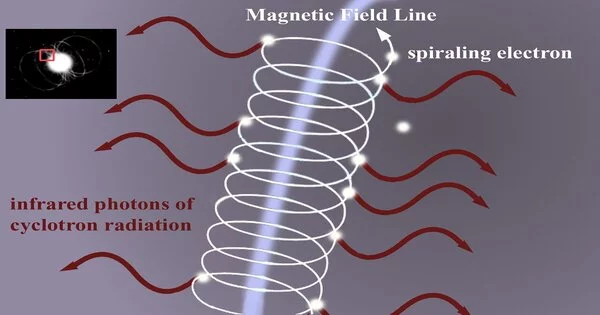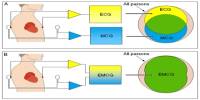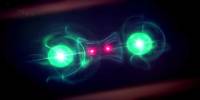The electromagnetic radiation released by non-relativistic speeding charged particles deflected by a magnetic field is known as cyclotron radiation. It is a type of electromagnetic radiation released by charged particles, often electrons or positrons, as they move in curved pathways in the presence of a magnetic field. It is also known as synchrotron radiation. This phenomenon is crucial in physics and astrophysics, such as particle accelerators, synchrotrons, and astrophysical sources.
The Lorentz force on the particles acts perpendicular to both the magnetic field lines and the particles’ motion through them, causing an acceleration of charged particles that causes them to emit radiation as they spiral around the magnetic field lines.
The term “cyclotron radiation” refers to a type of particle accelerator that has been used since the 1930s to generate very energetic particles for research purposes. The circular orbits that charged particles show in a uniform magnetic field are used by the cyclotron. Furthermore, the orbital period is independent of particle energy, allowing the cyclotron to run at a fixed frequency.
All charged particles traveling through magnetic fields, not simply those in cyclotrons, release cyclotron radiation. Cyclotron radiation from interstellar plasma, black holes, and other celestial events is a valuable source of knowledge on distant magnetic fields.
Key points about cyclotron radiation include:
- Magnetic Field: When charged particles, such as electrons, move in a circular or helical pattern within a magnetic field, this phenomenon happens. The charged particle experiences a force from the magnetic field, causing it to shift direction and release radiation.
- Energy Loss: The charged particle loses energy as it emits cyclotron radiation. This energy loss is a basic element of particle dynamics in magnetic fields, influencing charged particle behavior in a variety of physical systems.
- Characteristics: Depending on the energy and velocity of the charged particle, it is often emitted as electromagnetic waves such as radio waves, microwave radiation, and even X-rays.
- Synchrotron Radiation: While cyclotron radiation generally refers to the emission of radiation by a particle moving in a magnetic field with a fixed radius of curvature, synchrotron radiation is a similar phenomenon that occurs when the particle’s path is not necessarily circular. Synchrotron radiation is commonly used in particle accelerators and synchrotron light sources for various applications, including materials science and medical imaging.
Applications
Cyclotron radiation is useful in fields such as medical imaging and materials science. Synchrotron light sources are employed in a variety of study fields, including biology, chemistry, physics, and materials engineering.
In conclusion, cyclotron radiation is electromagnetic radiation emitted by charged particles moving in curved pathways in the presence of a magnetic field. This phenomenon has numerous applications in fundamental physics as well as practical technologies.
















